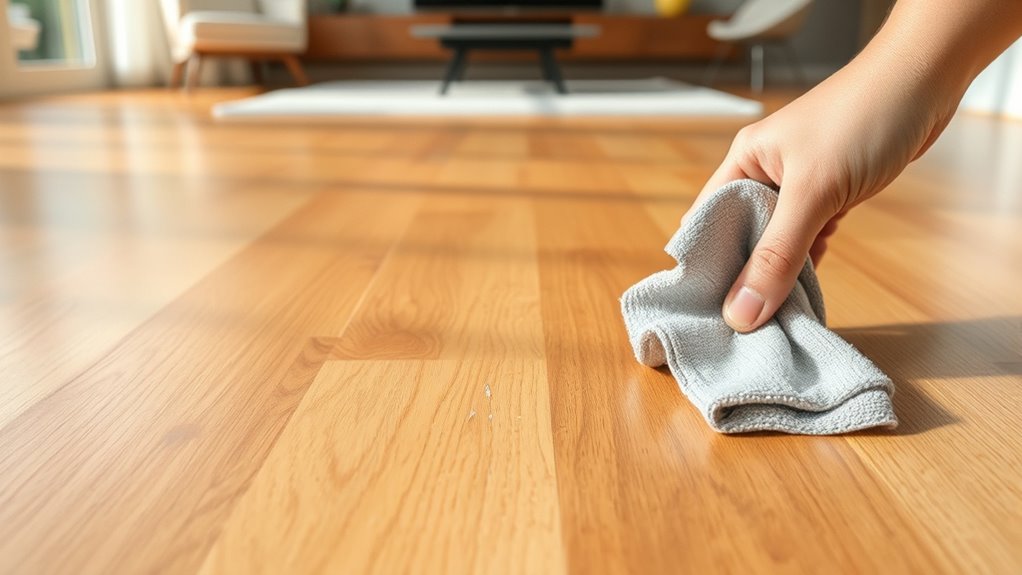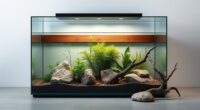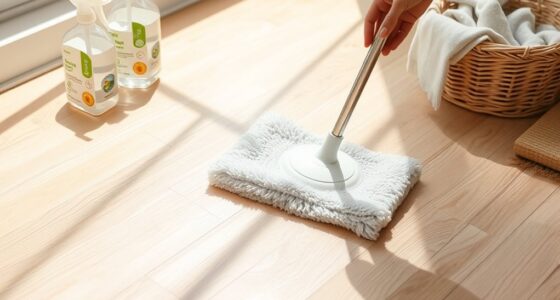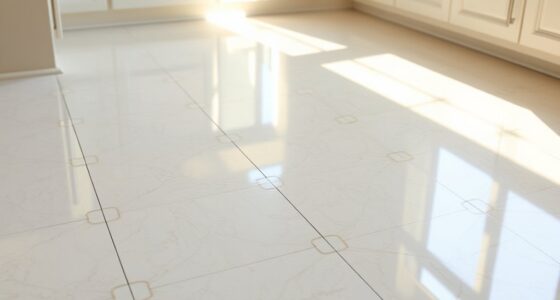Before mopping your engineered wood, make sure to vacuum thoroughly with a soft brush attachment to remove dirt and debris that can cause scratches. Protect furniture with pads to prevent marks, and use a damp microfiber mop with gentle cleaning solution in circular motions. Keep airborne dust low with an air purifier, and check that furniture pads are in good condition. Taking these steps now can keep your floors looking perfect—discover more ways to protect your flooring long-term.
Key Takeaways
- Vacuum floors thoroughly with a soft brush attachment to remove dirt and debris before mopping.
- Use furniture pads under heavy furniture legs to prevent scratches during cleaning.
- Ensure the mop is only lightly dampened and use gentle, circular motions when cleaning.
- Regularly inspect and replace worn furniture pads to maintain floor protection.
- Consider using an air purifier to reduce airborne dust and debris settling on the floor.
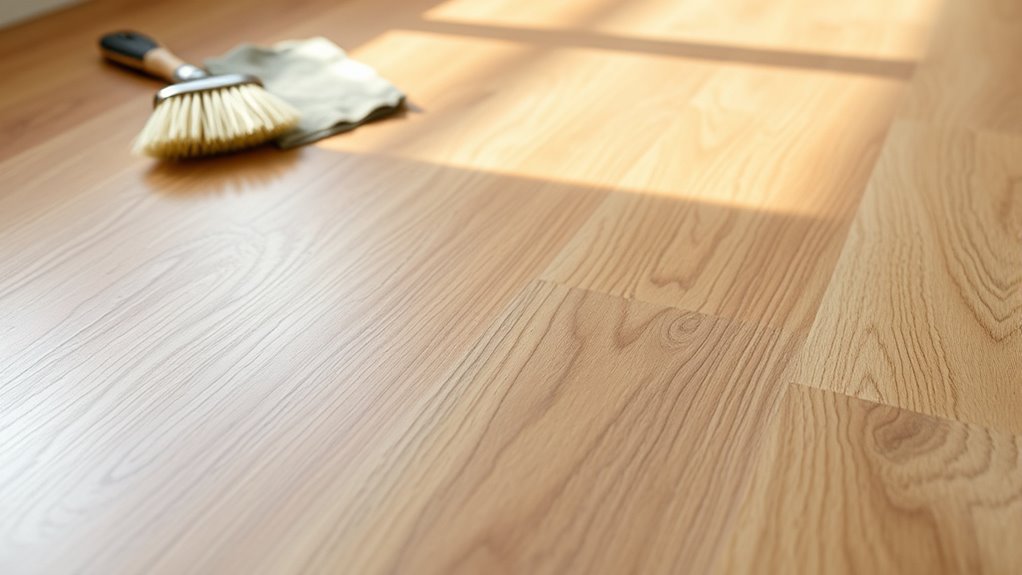
Engineered wood floors are durable and stylish, but scratches can quickly mar their appearance. Before you even think about mopping, it’s vital to prepare the surface properly. One of the best ways to prevent scratches is to keep your floor free of dirt and debris. Regular vacuum maintenance becomes your first line of defense. Use a vacuum with a soft brush attachment to gently pick up dirt, dust, and small particles that can cause scratches when walked on or when you move furniture. Avoid vacuums with harsh beater bars, as they can scratch the surface. By maintaining a consistent vacuum routine, you reduce the risk of debris turning into abrasive particles that damage your flooring over time.
Keep your engineered wood floors scratch-free with regular vacuuming using a soft brush attachment.
Another essential step before mopping is protecting your furniture. Heavy furniture, like sofas or tables, can leave marks or scratches if dragged across the floor. To prevent this, always place furniture pads underneath the legs of heavy pieces. These pads act as a barrier, distributing weight evenly and preventing scratches when you move or bump furniture. Opt for high-quality, felt or rubber pads that are designed specifically for flooring. They not only protect the surface but also make it easier to slide furniture around for cleaning or rearranging without risking damage.
When it comes to cleaning, avoid jumping straight into mopping without these precautions. First, ensure your vacuum has effectively removed all debris. Even tiny grains of sand or grit can cause scratches if they get caught between your mop and the floor. Once the floor is free of debris, dampen a microfiber mop with a gentle cleaning solution formulated for engineered wood. Never use excessive water, as too much moisture can warp or damage the flooring. Instead, lightly dampen the mop, and clean in gentle, circular motions. This approach minimizes the risk of scratches and keeps your floors looking pristine.
Additionally, consider using an air purifier in your home to reduce airborne dust and particles that settle on your floors, decreasing the frequency of debris buildup. Finally, consider establishing a routine that combines vacuum maintenance, furniture pad use, and gentle cleaning practices. Regularly inspecting your furniture pads and replacing them when worn ensures ongoing protection. Combining these steps before mopping will help you maintain the beauty of your engineered wood floors and prevent scratches from forming. Remember, a little proactive care goes a long way in preserving the lifespan and appearance of your floors, saving you time, money, and frustration in the long run.
Frequently Asked Questions
Can I Use a Steam Mop on Engineered Wood Floors?
You shouldn’t use steam mops on engineered wood floors because the heat and moisture can damage the protective coatings and cause warping. Steam mops generate humidity that penetrates the layers, risking swelling or delamination. Instead, opt for a damp microfiber cloth to clean, ensuring you preserve the floor’s finish and prevent scratches. Always check your floor’s manufacturer guidelines before cleaning with any device.
How Often Should I Reapply Protective Coatings to Prevent Scratches?
You should reapply the protective coating every 2 to 3 years to keep scratches at bay. Neglecting this schedule risks exposing your engineered wood to damage. Keep a close eye on the coating’s condition—once it starts showing wear or dullness, it’s time for a fresh layer. Regular reapplication ensures your floors stay resilient and beautiful, warding off scratches before they even begin. Don’t wait too long—timing is key.
Are There Specific Cleaning Products Safe for Engineered Wood?
When choosing wood cleaning products, always look for options specifically labeled safe for engineered wood. You should avoid harsh chemicals that can damage the surface. Opt for gentle, pH-neutral cleaners that effectively remove dirt and grime without compromising product safety. Regularly cleaning with the right products helps prevent scratches and maintains your flooring’s beauty. Always follow the manufacturer’s instructions for best results and to guarantee the longevity of your engineered wood.
What Are the Best Furniture Pads to Prevent Scratches?
To prevent scratches on your engineered wood, use furniture sliders and felt pads. Furniture sliders make moving heavy furniture easier without scratching the surface, while felt pads absorb impact and reduce friction. Attach felt pads to the bottoms of chair and table legs, and slide heavy furniture with sliders instead of dragging. Regularly check and replace pads to maintain protection, keeping your engineered wood looking pristine and scratch-free.
How Can I Remove Existing Scratches From Engineered Wood?
To remove existing scratches from engineered wood, start with scratch repair kits that contain fillers or touch-up pens matching your floor’s color. For deeper scratches, consider surface refinishing with a light buffing or applying a wood finish or sealant to blend the damage. Always clean the area thoroughly before any repair, and follow product instructions carefully to restore your floor’s appearance without causing further damage.
Conclusion
Remember, a stitch in time saves nine. By taking quick steps to prevent scratches—like using furniture pads and avoiding harsh cleaners—you’ll keep your engineered wood looking its best. Regular maintenance and mindful habits go a long way in preserving its beauty. Don’t wait until scratches become permanent; act now and enjoy a pristine, flawless floor for years to come. After all, an ounce of prevention is worth a pound of cure.
